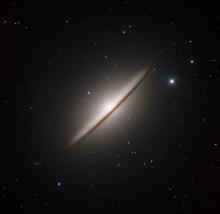Listen to today's episode of StarDate on the web the same day it airs in high-quality streaming audio without any extra ads or announcements. Choose a $8 one-month pass, or listen every day for a year for just $30.
You are here
Black Hole ‘Acorns’
According to an old saying, “from tiny acorns do mighty oak trees grow.” And mighty black holes must do the same thing. The problem is, astronomers aren’t sure just what form the black hole “acorns” take.
Supermassive black holes inhabit the hearts of most galaxies — and perhaps all of them. They can grow to billions of times the mass of the Sun. And some of them did so in the blink of a cosmic eye — in the first few hundred million years after the Big Bang.
Despite their reputation, though, black holes can’t gobble up enough stars and gas to grow that big that fast. So they must have grown from some sort of “seed” — something that was fairly heavy to begin with.
One possibility is the merger of a bunch of smaller black holes. The combined black hole would be massive enough to pull in enough material to grow to supermassive proportions.
Another possibility is giant clouds of dark matter — material that we can’t see, but that pulls on the stars and galaxies we can see. And yet another is mid-sized black holes that formed when compact but heavy clouds of gas collapsed.
It’s also possible that the first supermassive black holes formed from collapsing gas clouds directly. The clouds were so tightly packed that they couldn’t resist gravity’s powerful grip — making them “acorns” from which mighty black holes grew.
We’ll talk about a possible trail of stars behind a black hole tomorrow.
Script by Damond Benningfield






